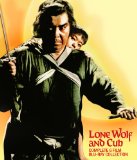| Reviews & Columns |
|
Reviews DVD TV on DVD Blu-ray 4K UHD International DVDs In Theaters Reviews by Studio Video Games Features Collector Series DVDs Easter Egg Database Interviews DVD Talk Radio Feature Articles Columns Anime Talk DVD Savant Horror DVDs The M.O.D. Squad Art House HD Talk Silent DVD
|
DVD Talk Forum |
|
|
| Resources |
|
DVD Price Search Customer Service #'s RCE Info Links |
|
Columns
|
|
|
Lone Wolf and Cub: Complete Six-Film Collection
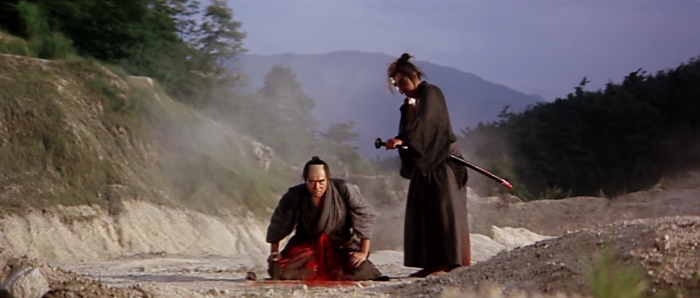 In a nutshell, this new Blu-Ray collection from AnimEigo collects all six original Lone Wolf and Cub films, adapted from the popular manga created by Kazuo Koike. Produced and released between 1972 and 1974, they captured the books' colorful celebration of poetic violence, bloodshed and revenge. These six films are briefly summarized below, followed by a technical review of AnimEigo's Blu-Ray collection.
Sword of Vengeance (1972) introduces us to Ogami Itto (Tomisaburo Wakayama, who stars in all six films), a skilled swordsman and wandering assassin in 18th century Japan. Roughly two months earlier, our anti-hero had been accused of treason by the Shogun's inspector and members of the Yagyu clan. His wife was slain and his tenure as the Shogun's executioner was over, so Itto now roams the country with his son, Daigoro. His only possessions are a trusty Dotanuki battle sword and Daigoro's baby cart, which has been outfitted with several concealed weapons and other armaments. Itto's first task is to slay a Chamberlain's rival, who's hiding in a small village near several hot springs. He's already established as a merciless killing machine and there's five more sequels, so you can imagine how that all plays out. Baby Cart at the River Styx (1972) catches up with Itto and son on their continuing journey, before our swordsman is contracted by a clan whose business secrets are threatened by a rival. Determined to finish the job, Itto is challenged by a group of deadly female assassins and Daigoro is eventually kidnapped after a fierce battle. The combination of both threats (rescuing Daigoro and slaying the rogue clan member) is paired with an increased level of action, giving Styx a more dynamic sense of momentum and intrigue. Though not without a few moments of unintentional hilarity, it's a solid sequel overall. Baby Cart to Hades (1972) expands upon the newfound sense of sacrifice displayed during Styx; this time around, Itto protects both Daigoro and a young prostitute named Omatsu. She's eventually freed from her "job", but the clan that originally bought her wants something in return: the services of Itto to slay a well-armed deputy. Loaded with action and a more refined sense of character dynamics, Hades definitely feels like a natural progression for the series and stands as one of the most enduring entries. Easy highlights include a rousing battle between Itto and the deputy's 200-man army, as well as a duel with master swordsman Magomura Kanbei (played memorably by Go Kato of Samurai Rebellion).
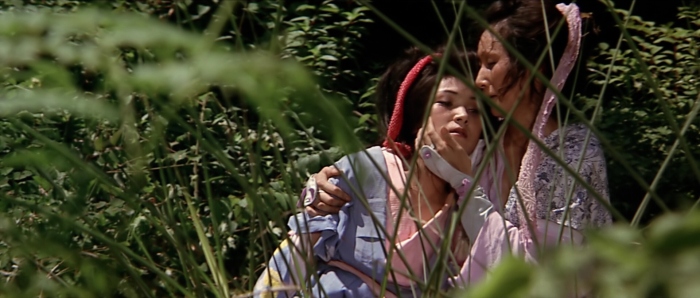 Baby Cart in Peril (1972) pits Itto against a deadly female assassin named Oyuki, though he also continues to be pursued by the Yagyu clan (specifically Gunbei, a son of one-eyed Retsudo, who at one point competed against Itto for his job as the shogun's official executioner). It's also worth noting that Peril shifts a little more of the focus to three year-old Daigoro, who is separated from Itto for several days after wandering from the cart. He's still obviously a handicap more often than not, but Daigoro begins to show added resolve and their unique bond continues to strengthen because of it. Baby Cart in the Land of Demons (1973) continues the series' formula of bloodshed framed by Itto's unyielding code of honor, continuing the development of his bond with Daigoro and throwing in a bit more political intrigue just for fun. After his life is threatened by an assassin and five members of the Kuroda clan, Itto learns that the clan's leader is keeping the rightful heir locked away and has secretly put his daughter in position to take his place. Meanwhile, Daigoro is once again separated from his father and punished by local authorities while taking the blame for a young pickpocket. Though the formula feels a bit similar to Peril at times, this chapter of Itto and Daigoro's journey is still a necessary one. White Heaven in Hell (1974) stands as the black sheep of the series; not only because it's the only chapter not directed by Kenji Misumi, but it's the weakest of the six. Still, this final chapter of the series at least presents a bit of closure, as Retsudo Yagyu finally seems to be within reach of Itto's blade. Standing in the way is Retsudo's only daughter (the deadly Kaori), his illegitimate son Hoyouei and the surviving clan members. White Heaven is engaging at times, but the pacing feels off and several loose ends are never tied up as much as we'd like. If nothing else, the kill count for Itto is astronomically high, so anyone who's simply hoping for an action-packed conclusion won't feel the sting of disappointment.
Samurai fanatics should already be familiar with Shogun Assassin (1980), which spliced together chunks of the first two films for American audiences and slapped on an English dub just for bad measure. The other four films were also released stateside, though similarly burdened with sporadic edits, new titles and butchered audio. Interestingly enough, AnimEigo's new two-disc collection marks the first domestic Blu-Ray release of the six original films, complete with the Japanese audio tracks. Unfortunately, they chose to squash roughly four hours of HD content on each dual-layered disc, but also didn't bother to include any extras. If those sound like bad ideas...trust me, there's more where that came from.
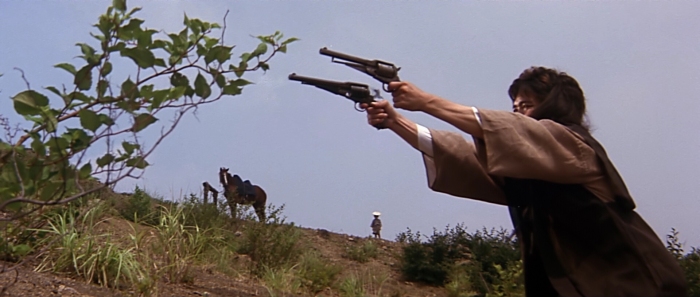
Firstly, I'd like to thank our own Ian Jane for these screen caps, which can be viewed at full resolution in his fine review over at Rock! Shock! Pop!. Unfortunately, he's the only person who deserves any thanks, because this 1080p visual presentation is basically ruined by excessive digital noise reduction. Compared to the excellent treatment of Shogun Assassin (which is shown via screen caps linked in Ian's review), each of these six movies looks like a waxy, smeary mess. A fair amount of dirt can also be spotted during certain scenes, but this isn't too distracting. It's a real shame, because there's not a great deal to complain about otherwise: the color palette is vivid, none of the original 2.35:1 compositions have been compromised and black levels are quite good, for starters. Overall, the noise reduction issues alone are basically a deal-breaker, unless a severe lack of texture and image detail doesn't bother you at all. There's thankfully much less to complain about in the audio department, as the main benefit to this release is that all six movies are blessed with the original Japanese LPCM mono tracks. It's a relatively thin track with very little in the way of dynamics...but hey, pops and hiss are minimal, it's not dubbed and there's no goofy 5.1 remix, so it could be a lot worse. The optional English subtitles are colorful but concise and easy to follow, and you'll even learn a few Japanese vocab words if you're a fast reader.
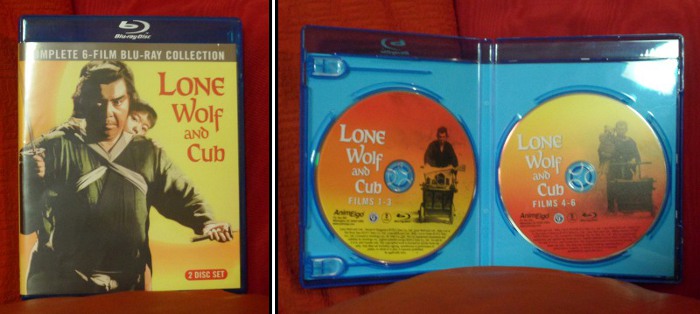
The Lone Wolf and Cub film series isn't exactly high art, but its poetic violence and colorful characters are, in the right mood, insanely entertaining. Whether you space these six films out or go for a marathon, there's an definite spark here that should appeal to any and all samurai fans. Unfortunately, AnimEigo's Blu-Ray collection comes up short: not only have all six films been scrubbed vigorously with DNR, but the plain presentation and lack of extras makes this feel more like a public domain effort. Only a select few will tolerate this release's drawbacks; everyone else should give it a weekend spin first. Rent It.
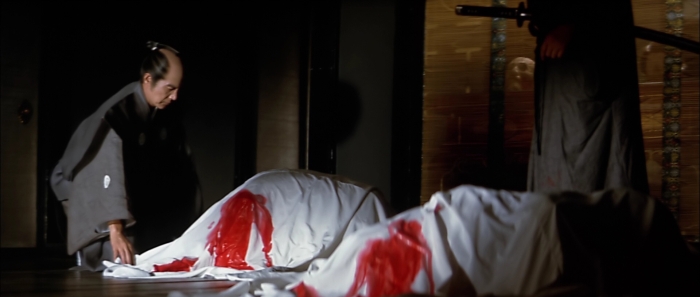
|
|
| Popular Reviews |
| Sponsored Links |
|
|
| Sponsored Links |
|
|
| Release List | Reviews | Shop | Newsletter | Forum | DVD Giveaways | Blu-Ray | Advertise |
|
Copyright 2024 DVDTalk.com All Rights Reserved. Legal Info, Privacy Policy, Terms of Use,
Manage Preferences,
Your Privacy Choices | |||||||









